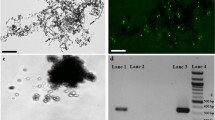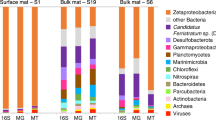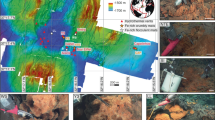Abstract
Neutrophilic Fe-oxidizing bacteria (FeOB) are often identified by their distinctive morphologies, such as the extracellular twisted ribbon-like stalks formed by Gallionella ferruginea or Mariprofundus ferrooxydans. Similar filaments preserved in silica are often identified as FeOB fossils in rocks. Although it is assumed that twisted iron stalks are indicative of FeOB, the stalk's metabolic role has not been established. To this end, we studied the marine FeOB M. ferrooxydans by light, X-ray and electron microscopy. Using time-lapse light microscopy, we observed cells excreting stalks during growth (averaging 2.2 μm h−1). Scanning transmission X-ray microscopy and near-edge X-ray absorption fine structure (NEXAFS) spectroscopy show that stalks are Fe(III)-rich, whereas cells are low in Fe. Transmission electron microscopy reveals that stalks are composed of several fibrils, which contain few-nanometer-sized iron oxyhydroxide crystals. Lepidocrocite crystals that nucleated on the fibril surface are much larger (∼100 nm), suggesting that mineral growth within fibrils is retarded, relative to sites surrounding fibrils. C and N 1s NEXAFS spectroscopy and fluorescence probing show that stalks primarily contain carboxyl-rich polysaccharides. On the basis of these results, we suggest a physiological model for Fe oxidation in which cells excrete oxidized Fe bound to organic polymers. These organic molecules retard mineral growth, preventing cell encrustation. This model describes an essential role for stalk formation in FeOB growth. We suggest that stalk-like morphologies observed in modern and ancient samples may be correlated confidently with the Fe-oxidizing metabolism as a robust biosignature.
Similar content being viewed by others
Log in or create a free account to read this content
Gain free access to this article, as well as selected content from this journal and more on nature.com
or
References
Alt JC . (1988). Hydrothermal oxide and nontronite deposits on seamounts in the eastern Pacific. Mar Geol 81: 227–239.
Bailey JV, Joye SB, Kalanetra KM, Flood BE, Corsetti FA . (2007). Evidence of giant sulphur bacteria in Neoproterozoic phosphorites. Nature 445: 198–201.
Banfield JF, Moreau JW, Chan CS, Welch SA . (2001). Mineralogical biosignatures and the search for life on Mars. Astrobiology 1: 447–465.
Bazylinski DA, Frankel RB . (2003). Biologically controlled mineralization in prokaryotes. Rev Mineral Geochem 54: 217–247.
Bekker A, Holland HD, Wang PL, Rumble D, Stein HJ, Hannah JL et al. (2004). Dating the rise of atmospheric oxygen. Nature 427: 117–120.
Boyce CK, Cody GD, Feser M, Jacobsen C, Knoll AH, Wirick S . (2002). Organic chemical differentiation within fossil plant cell walls detected with x-ray spectromicroscopy. Geology 30: 1039–1042.
Brandes J, Lee C, Wakeham S, Peterson M, Jacobsen C, Wirick S et al. (2004). Examining marine particulate organic matter at sub-micron scales using scanning transmission x-ray microscopy and carbon x-ray absorption near edge structure spectroscopy. Mar Chem 92: 107–121.
Chan CS, Fakra SC, Edwards DC, Emerson D, Banfield JF . (2009). Iron oxyhydroxide mineralization on microbial extracellular polysaccharides. Geochim Cosmochim Acta 73: 3807–3818.
Cody G, Ade H, Wirick S, Mitchell GD, Davis A . (1998). Determination of chemical-structural changes in vitrinite accompanying luminescence alteration using C-NEXAFS analysis. Org Geochem 28: 441–455.
Croal LR, Jiao Y, Kappler A, Newman DK . (2009). Phototrophic Fe(II) oxidation in an atmosphere of H2: implications for archean banded iron formations. Geobiology 7: 21–24.
de Groot F, Grioni M, Fuggle J, Ghijsen J, Sawatzky G, Petersen H . (1989). Oxygen 1s x-ray-absorption edges of transition-metal oxides. Physical Review B 40: 5715–5723.
Druschel G, Emerson D, Sutka R, Suchecki P, Luther GW . (2008). Low-oxygen and chemical kinetic constraints on the geochemical niche of neutrophilic iron(II) oxidizing microorganisms. Geochim Cosmochim Acta 72: 3358–3370.
Emerson D, Floyd MM . (2005). Enrichment and isolation of iron-oxidizing bacteria at neutral pH. Methods Enzymol 397: 112–123.
Emerson D, Moyer C . (1997). Isolation and characterization of novel iron-oxidizing bacteria that grow at circumneutral pH. Appl Environ Microbiol 63: 4784–4792.
Emerson D, Moyer CL . (2002). Neutrophilic Fe-oxidizing bacteria are abundant at the Loihi Seamount hydrothermal vents and play a major role in Fe oxide deposition. Appl Environ Microbiol 68: 3085–3093.
Emerson D, Rentz JA, Lilburn T, Davis R, Aldrich H, Chan C et al. (2007). A novel lineage of Proteobacteria involved in formation of marine Fe-oxidizing microbial mat communities. PLoS ONE 2: e667.
Farquhar J, Bao H, Thiemens M . (2000). Atmospheric influence of Earth′s earliest sulfur cycle. Science 289: 756–758.
Fenchel T . (1994). Motility and chemosensory behaviour of the sulphur bacterium Thiovulum majus. Microbiology 140: 3109–3116.
Garcia-Ruiz JM, Hyde ST, Carnerup AM, Christy AG, Van Kranendonk MJ, Welham NJ . (2003). Self-assembled silica-carbonate structures and detection of ancient microfossils. Science 302: 1194–1197.
Garcia-Ruiz JM, Melero-Garcia E, Hyde ST . (2009). Morphogenesis of self-assembled nanocrystalline materials of barium carbonate and silica. Science 323: 362–365.
Ghiorse WC . (1984). Biology of iron-depositing and manganese-depositing bacteria. Annu Rev Microbiol 38: 515–550.
Hallbeck L, Pedersen K . (1991). Autotrophic and mixotrophic growth of Gallionella ferruginea. J Gen Microbiol 137: 2657–2661.
Hallbeck L, Pedersen K . (1995). Benefits associated with the stalk of Gallionella ferruginea, evaluated by comparison of a stalk-forming and a non-stalk- forming strain and biofilm studies in-situ. Microb Ecol 30: 257–268.
Hanert HH . (1999). The genus Gallionella. In: Dworkin M, Falkow S, Rosenberg E, Schleifer K-H, Stackebrandt E (eds). The Prokaryotes: An Evolving Electronic Resource for the Microbiological Community. Springer-Verlag: New York.
Hofmann BA, Farmer JD, Von Blanckenburg F, Fallick AE . (2008). Subsurface filamentous fabrics: an evaluation of origins based on morphological and geochemical criteria, with implications for exopaleontology. Astrobiology 8: 87–117.
Johnson CM, Beard BL, Roden EE . (2008). The iron isotope fingerprints of redox and biogeochemical cycling in modern and ancient Earth. Annu Rev Earth Planet Sci 36: 457–493.
Kappler A, Newman DK . (2004). Formation of Fe(III)-minerals by Fe(II)-oxidizing photoautotrophic bacteria. Geochim Cosmochim Acta 68: 1217–1226.
Kennedy CB, Scott SD, Ferris FG . (2004). Hydrothermal phase stabilization of 2-line ferrihydrite by bacteria. Chem Geol 212: 269–277.
Kilcoyne ALD, Tyliszczak T, Steele WF, Fakra S, Hitchcock P, Franck K et al. (2003). Interferometer-controlled scanning transmission x-ray microscopes at the advanced light source. J Synchrotron Radiat 10: 125–136.
Little CTS, Glynn SEJ, Mills RA . (2004). Four-hundred-and-ninety-million-year record of bacteriogenic iron oxide precipitation at sea-floor hydrothermal vents. Geomicrobiol J 21: 415–429.
Miot J, Benzerara K, Obst M, Kappler A, Hegler F, Schadler S et al. (2009). Extracellular iron biomineralization by photoautotrophic iron-oxidizing bacteria. Appl Environ Microbiol 75: 5586–5591.
Muyzer G, Yildirim E, van Dongen U, Kühl M, Thar R . (2005). Identification of ‘Candidatus Thioturbo danicus,’ a microaerophilic bacterium that builds conspicuous veils on sulfidic sediments. Appl Environ Microbiol 71: 8929–8933.
Myneni SCB . (2002). Soft x-ray spectroscopy and spectromicroscopy studies of organic molecules in the environment. Rev Mineral Geochem 49: 485–579.
Rentz JA, Kraiya C, Luther GW, Emerson D . (2007). Control of ferrous iron oxidation within circumneutral microbial iron mats by cellular activity and autocatalysis. Environ Sci Technol 41: 6084–6089.
Schädler S, Burkhardt C, Hegler F, Straub KL, Miot J, Benzerara K et al. (2009). Formation of cell-iron-mineral aggregates by phototrophic and nitrate-reducing anaerobic Fe(II)-oxidizing bacteria. Geomicrobiol J 26: 93–103.
Shen Y, Buick R, Canfield DE . (2001). Isotopic evidence for microbial sulphate reduction in the early Archaean era. Nature 410: 77–81.
Sievert SM, Wieringa E, Wirsen CO, Taylor CD . (2007). Growth and mechanism of filamentous-sulfur formation by Candidatus Arcobacter sulfidicus in opposing oxygen-sulfide gradients. Environ Microbiol 9: 271–276.
Slack JF, Grenne T, Bekker A, Rouxel OJ, Lindberg PA . (2007). Suboxic deep seawater in the late Paleoproterozoic: evidence from hematitic chert and iron formation related to seafloor-hydrothermal sulfide deposits, central Arizona, USA. Earth Planet Sci Lett 255: 243–256.
Solomon D, Lehmann J, Kinyangi J, Liang B, Heymann K, Dathe L et al. (2009). Carbon (1 s) NEXAFS spectroscopy of biogeochemically relevant reference organic compounds. Soil Sci Soc Am J 73: 1817–1830.
Stohr J . (1992). NEXAFS Spectroscopy. Springer-Verlag: Berlin, pp 402.
Stookey LL . (1970). Ferrozine--a new spectrophotometric reagent for iron. Anal Chem 42: 779–781.
Summons RE, Jahnke LL, Hope JM, Logan GA . (1999). 2-Methylhopanoids as biomarkers for cyanobacterial oxygenic photosynthesis. Nature 400: 554–557.
Thar R, Kuhl M . (2002). Conspicuous veils formed by vibrioid bacteria on sulfidic marine sediment. Appl Environ Microbiol 68: 6310–6320.
Thar R, Kuhl M . (2003). Bacteria are not too small for spatial sensing of chemical gradients: an experimental evidence. Proc Natl Acad Sci 100: 5748–5753.
Tivanski AV, Hopkins RJ, Tyliszczak T, Gilles MK . (2007). Oxygenated interface on biomass burn tar balls determined by single particle scanning transmission x-ray microscopy. J Phys Chem A 111: 5448–5458.
Todd E, Sherman DM, Purton JA . (2003). Surface oxidation of pyrite under ambient atmospheric and aqueous (pH = 2 to 10) conditions: electronic structure and mineralogy from x-ray absorption spectroscopy. Geochim Cosmochim Acta 67: 881–893.
Toner BM, Santelli CM, Marcus MA, Wirth R, Chan CS, McCollom T et al. (2009). Biogenic iron oxyhydroxide formation at mid-ocean ridge hydrothermal vents: Juan de Fuca Ridge. Geochim Cosmochim Acta 73: 388–403.
Tortell PD, Maldonado MT, Price NM . (1996). The role of heterotrophic bacteria in iron-limited ocean ecosystems. Nature 383: 330–332.
Urquhart SG, Ade H . (2002). Trends in the carbonyl core (C 1S, O 1S) π*C=O transition in the near-edge x-ray absorption fine structure spectra of organic molecules. The J Phys Chem B 106: 8531–8538.
Vargas M, Kashefi K, Blunt-Harris EL, Lovley DR . (1998). Microbiological evidence for Fe (III) reduction on early Earth. Nature 395: 65–67.
Weiss JV, Rentz JA, Plaia T, Neubauer SC, Merrill-Floyd M, Lilburn T et al. (2007). Characterization of neutrophilic Fe(II)-oxidizing bacteria isolated from the rhizosphere of wetland plants and description of Ferritrophicum radicicola gen. nov. sp. nov., and Sideroxydans paludicola sp. nov. Geomicrobiol J 24: 559–570.
Williams KH, Ntarlagiannis D, Slater LD, Dohnalkova A, Hubbard SS, Banfield JF . (2005). Geophysical imaging of stimulated microbial biomineralization. Environ Sci Technol 39: 7592–7600.
Acknowledgements
TEM analyses were performed at the Berkeley National Center for Electron Microscopy, at the Marine Biological Laboratory and at the University of Delaware Bioimaging Facility. We thank Reena Zalpuri (Berkeley) for ultramicrotoming samples, Natalie Villa (University of Delaware) for performing lectin studies and Shawn French (University of Guelph) for providing LPS standard. We thank T Tyliszczak and ALD Kilcoyne for support at the Advanced Light Source BL11.0.2 and 5.3.2, respectively, and Jill Banfield for helpful discussions. Funding was provided by a NSF Ridge 2000 postdoctoral fellowship (CSC, KJE), by the NSF Microbial Observatories Program (KJE, DE) and by the NASA Astrobiology Institute (KJE, DE). ALS is supported by the Office of Science, Basic Energy Sciences, Division of Materials Science of the United States Department of Energy (DE-AC02-05CH11231).
Author information
Authors and Affiliations
Corresponding author
Additional information
Supplementary Information accompanies the paper on The ISME Journal website
Rights and permissions
About this article
Cite this article
Chan, C., Fakra, S., Emerson, D. et al. Lithotrophic iron-oxidizing bacteria produce organic stalks to control mineral growth: implications for biosignature formation. ISME J 5, 717–727 (2011). https://doi.org/10.1038/ismej.2010.173
Received:
Revised:
Accepted:
Published:
Issue date:
DOI: https://doi.org/10.1038/ismej.2010.173
Keywords
This article is cited by
-
Diversity and distribution of iron-oxidising bacteria belonging to Gallionellaceae in different sites of a hydroelectric power plant
Brazilian Journal of Microbiology (2024)
-
Aerobic and anaerobic iron oxidizers together drive denitrification and carbon cycling at marine iron-rich hydrothermal vents
The ISME Journal (2021)
-
Changes in the microbial community during microbial microaerophilic Fe(II) oxidation at circumneutral pH enriched from paddy soil
Environmental Geochemistry and Health (2021)
-
Uranium and neptunium retention mechanisms in Gallionella ferruginea/ferrihydrite systems for remediation purposes
Environmental Science and Pollution Research (2021)
-
Effect of tectonic processes on biosphere–geosphere feedbacks across a convergent margin
Nature Geoscience (2021)



